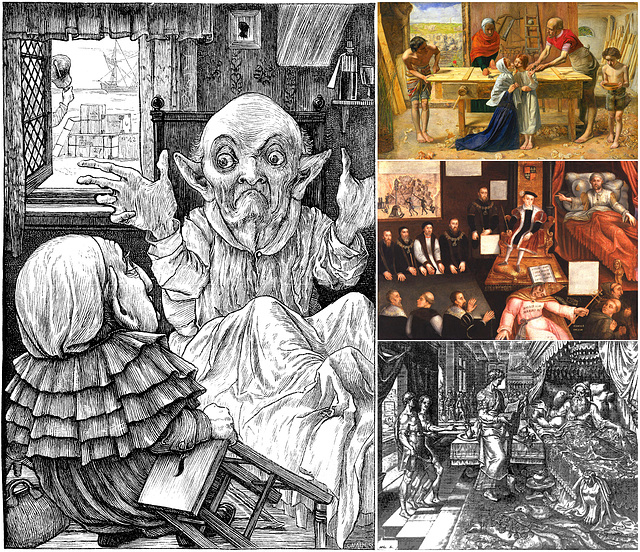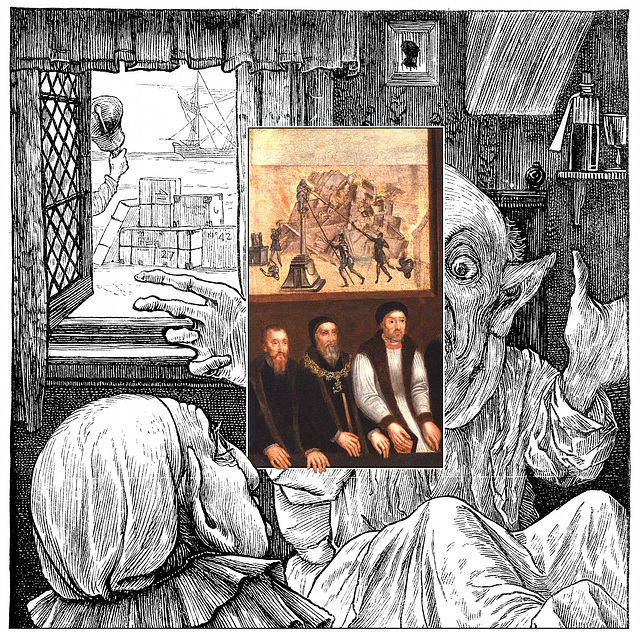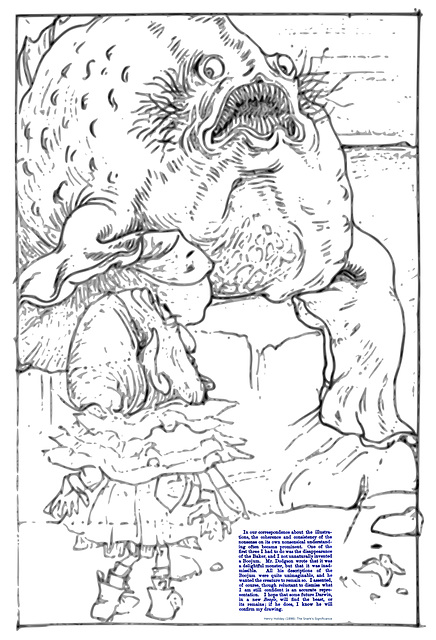
The Baker
Folder: The Hunting of the Snark
25 Feb 2012
1 favorite
4 comments
Holiday - Millais - Anonymous - Galle
See also: www.academia.edu/9856486/Henry_Holiday_-_and_Millais_Christ_in_the_House_of_His_Parents_
.
The discovery here is the allusion by Henry Holiday to the painting by J.E. Millais. Finding Millais' allusions to an anonymous painter and to Galle's print is a "bycatch" of my Snark hunt. The relation between the anonymous painting and Galle's print already has been explained by Margaret Aston in 1994. That relation brobably has been discovered even earlier by Millais.
.
[left]: Henry Holiday: Depiction (1876) of the Baker 's visit to his uncle in Lewis Carroll's " The Hunting of the Snark " (engraved by Joseph Swain). Outside of the window are some of the Baker's 42 boxes.
[right top]: John Everett Millais : Christ in the House of His Parents aka The Carpenter's Shop (1850).
Location: Tate Britain (N03584) , London.
Literature:
* Deborah Mary Kerr (1986): John Everett Millais's Christ in the house of his parents ( circle.ubc.ca/handle/2429/26546 )
p.34 in (01) Éva Péteri (2003): Victorian Approaches to Religion as Reflected in the Art of the Pre-Raphaelites, Budapest 2003, ISBN 978-9630580380 (shortlink: www.snrk.de/EvaPeteri.htm )
* Albert Boime (2008): Art in an Age of Civil Struggle, 1848-1871
p. 225-364: The Pre-Raphaelites and the 1848 Revolution ( en.wikipedia.org/wiki/Special:BookSources/0226063283 )
[right middle]: Anonymous : Edward VI and the Pope , An Allegory of Reformation, mirrored view (16th century, NPG 4165 ). Iconoclasm depicted in the window. Under the "window" 3rd from left is Thomas Cranmer who wrote the 42 Articles in 1552.
Edward VI and the Pope (NPG 4165) was, until 1874, the property of Thomas Green, Esq., of Ipswich and Upper Wimpole Street , a collection 'Formed by himself and his Family during the last Century and early Part of the present Century' (Roy C. Strong: Tudor and Jacobean Portraits , 1969, p.345). Thus, when Millais' Christ in the House of His Parents ('The Carpenter's Shop') was painted in 1849-1850, the 16th century painting was part of a private collection. It was sold by Christie's 20 March 1874 (lot 9) to a buyer unknown to me, that is, when Holiday started with his illustrations to The Hunting of the Snark .
Location: National Portrait Gallery, London
[right bottom]: Philip Galle after Maarten van Heemskerck , Redrawn print Ahasuerus consulting the records (1564). The resemblance to the image above (right middle) was shown by Dr. Margaret Aston in 1994 in The King's Bedpost: Reformation and Iconography in a Tudor Group Portrait (p. 68). She also compared the bedpost to Heemskerck's Esther Crowned by Ahasuerus .
Location: Rijksmuseum, Amsterdam
11 Apr 2012
1 favorite
3 comments
Holiday - Millais - Anonymous - Galle
See also: www.academia.edu/9856486/Henry_Holiday_-_and_Millais_Christ_in_the_House_of_His_Parents_
.
The discovery here is the allusion by Henry Holiday to the painting by J.E. Millais. Finding Millais' allusions to an anonymous painter and to Galle's print is a "bycatch" of my Snark hunt. The relation between the anonymous painting and Galle's print already has been explained by Margaret Aston in 1994. That relation brobably has been discovered even earlier by Millais.
.
[left]: Henry Holiday: Depiction (1876) of the Baker's visit to his uncle in Lewis Carroll's " The Hunting of the Snark " (engraved by Joseph Swain). Outside of the window are some of the Baker's 42 boxes.
[right top]: John Everett Millais : Christ in the House of His Parents aka The Carpenter's Shop (1850).
Location: Tate Britain (N03584) , London.
Literature:
* Deborah Mary Kerr (1986): John Everett Millais's Christ in the house of his parents ( circle.ubc.ca/handle/2429/26546 )
* p.34 in (01) Éva Péteri (2003): Victorian Approaches to Religion as Reflected in the Art of the Pre-Raphaelites, Budapest 2003, ISBN 978-9630580380 (shortlink: www.snrk.de/EvaPeteri.htm )
* Albert Boime (2008): Art in an Age of Civil Struggle, 1848-1871
p. 225-364: The Pre-Raphaelites and the 1848 Revolution ( en.wikipedia.org/wiki/Special:BookSources/0226063283 )
[right middle]: Anonymous : Edward VI and the Pope , An Allegory of Reformation, mirrored view (16th century, NPG 4165 ). Iconoclasm depicted in the window. Under the "window" 3rd from left is Thomas Cranmer who wrote the 42 Articles in 1552.
Edward VI and the Pope (NPG 4165) was, until 1874, the property of Thomas Green, Esq., of Ipswich and Upper Wimpole Street , a collection 'Formed by himself and his Family during the last Century and early Part of the present Century' (Roy C. Strong: Tudor and Jacobean Portraits , 1969, p.345). Thus, when Millais' Christ in the House of His Parents ('The Carpenter's Shop') was painted in 1849-1850, the 16th century painting was part of a private collection. It was sold by Christie's 20 March 1874 (lot 9) to a buyer unknown to me, that is, when Holiday started with his illustrations to The Hunting of the Snark .
Location: National Portrait Gallery, London
[right bottom]: Philip Galle after Maarten van Heemskerck , Redrawn print Ahasuerus consulting the records (1564). The resemblance to the image above (right middle) was shown by Dr. Margaret Aston in 1994 in The King's Bedpost: Reformation and Iconography in a Tudor Group Portrait (p. 68). She also compared the bedpost to Heemskerck's Esther Crowned by Ahasuerus .
Location: Rijksmuseum, Amsterdam
03 Jun 2013
1 favorite
11 comments
Thomas Cranmer's 42 Boxes
"I personally don't look for secret messages hidden by Carroll in the text; rather, I look at themes and symbols as potential hints as to the sorts of things that were on Carroll's mind at the time."
Darien Graham-Smith , 2005-10-05
The image:
[B&W]: Upper part of Henry Holiday's illustration (1876) to The Baker's Tale in Lewis Carroll's The Hunting of the Snark depicting some of the Baker's 42 boxes piled up outside the window. In 1552, shortly before the early death of Edward VI, Thoma s Cran mer wrote down 42 articles , a protestant doctrine. In Henry Holiday's depiction of the staple of some of the Baker's 42 boxes piled up outside of the window of the Baker's uncle's room also the number 42 is visible.
[color]: Segment from a painting (c. 1570) by an unknown artist ( commons.wikimedia.org/wiki/File:Ed_and_pope.png ).The segment is displayed in a mirrored view. Thomas Cranmer is located on the right side in the mirrored image. (Among other persons in the painting not shown in this segment: Edward VI, Henry VIII).
There is a book about this painting where Thomas Cranmer is identified: Margaret Aston, The King's Bedpost: Reformation and Iconography in a Tudor Group Portrait , 1994.
·
42 and Thomas Cranmer:
How could the number 42 get into anyone's mind? Douglas Adams made that number popular as an answer to everything. (But what was the question?) In The Hitchhiker's Guide to the Galaxy he (similar to many other writers, e.g. Tom Stoppard) challenged his readers with allusions to the works of earlier writers. An earlier writer who had an obvious affinity to the number 42 is known as Lewis Carroll. And, as I learned from John Tufail , "before the 39 articles of Faith that Carroll [the Rev. Dodgson] declined to attest to, there were 42 articles [written by Thomas Cranmer]."
Of course, like Adams, Carroll wouldn't give any good reason for his affinity (not only in the Snark ) to the number 42 either, but he surely knew, that "Forty-Two" is an important number in the history of Anglicanism: In the mind of Charles Lutwidge Dodgson (aka Lewis Carroll) the Forty-Two Articles of Thomas Cranmer surely had their place.
· · · · 021 · · There was one who was famed for the number of things
· · · · 022 · · · · He forgot when he entered the ship:
· · · · 023 · · His umbrella, his watch, all his jewels and rings,
· · · · 024 · · · · And the clothes he had bought for the trip.
· · · · 025 · · He had forty-two boxes , all carefully packed,
· · · · 026 · · · · With his name painted clearly on each:
· · · · 027 · · But, since he omitted to mention the fact,
· · · · 028 · · · · They were all left behind on the beach.
· · · · 029 · · The loss of his clothes hardly mattered, because
· · · · 030 · · · · He had seven coats on when he came,
· · · · 031 · · With three pairs of boots --but the worst of it was,
· · · · 032 · · · · He had wholly forgotten his name.
· · · · 033 · · He would answer to "Hi!" or to any loud cry,
· · · · 034 · · · · Such as " Fry me! " or " Fritter my wig! "
· · · · 035 · · To "What-you-may-call-um!" or "What-was-his-name!"
· · · · 036 · · · · But especially "Thing-um-a-jig!"
· · · · 037 · · While, for those who preferred a more forcible word,
· · · · 038 · · · · He had different names from these:
· · · · 039 · · His intimate friends called him " Candle-ends ,"
· · · · 040 · · · · And his enemies " Toasted-cheese ."
· · · · 041 · · "His form is ungainly--his intellect small--"
· · · · 042 · · · · (So the Bellman would often remark)
· · · · 043 · · "But his courage is perfect! And that, after all,
· · · · 044 · · · · Is the thing that one needs with a Snark."
· · · · 045 · · He would joke with hyenas, returning their stare
· · · · 046 · · · · With an impudent wag of the head :
· · · · 047 · · And he once went a walk, paw-in-paw, with a bear ,
· · · · 048 · · · · "Just to keep up its spirits," he said.
· · · · 049 · · He came as a Baker: but owned, when too late--
· · · · 050 · · · · And it drove the poor Bellman half-mad--
· · · · 051 · · He could only bake Bridecake--for which, I may state,
· · · · 052 · · · · No materials were to be had.
·
·
Background:
The Baker in Lewis Carroll's The Hunting of the Snark has many features in common with Thomas Cramer. Many of his nick names are associated with heat or having been burnt : "Fry me!" or "Fritter my wig!", "Candle-ends" or "Toasted-cheese".
Cranmer later was accused of heresy and had to leave his articles behind him before he heroically recanted his recantations: "On 14 February 1556, he was degraded from his episcopal and sacerdotal offices in preparation for execution. Following his trial, Cranmer was put under intense pressure to recant. Desperately lonely and broken, Cranmer at last signed a series of six recantations, the last of which rejected his entire theological development. Although the more traditional practice was to impose a lesser sentence on recanted heretics, Mary maintained that Cranmer should burn . On 21 March 1556, Cranmer was to recant publicly, using a speech that had been endorsed by the government before suffering his punishment. Instead, he stunned the authorities and the gathered crowd by recanting not his earlier theological positions but the recantations themselves. He then ran to the stake and steadfastly held his right hand, the hand that had signed the recantations, in the fire . His heroic end undid much of the government's planned propaganda against him and his Protestant cause and earned him an honored place in Foxe's catalog of Protestant martyrs." ( Encyclopedia Britannica, 1911 )
"Mary Tudor suppressed the 42 Articles when she returned England to the Catholic faith; however, Cranmer's work became the source of the 39 Articles which Elizabeth I established as the doctrinal foundations of the Church of England. There are two editions of the 39 Articles: those of 1563 are in Latin and those of 1571 are in English." ( Victorian Web )
02 Aug 2010
2 comments
Kerchiefs and other shapes
[left]: Redrawn segment from one of Henry Holiday's pencil drafts for the depiction of the Baker's visit to his uncle (1876) in Lewis Carroll's The Hunting of the Snark .
[right]: John Everett Millais : Redrawn Segment from Christ in the House of His Parents (1850) depicting Mary (and a part of Christ's face in the upper right corner).
This example shows how Holiday worked on the construction of his conundrums in his illustrations to Lewis Carroll's The Hunting of the Snark . Even though Holiday copied a face from a face, he reinterprated shapes of face elements from the source face in order to represent different face elements with a resembling shape in the target face. The baker's ear is based on a shape in the depiction of Marie's face which is no ear. The same partially applies to the Baker's nose and the baker's eye.
Such kind of pictorial obfuscation should not be a surprise as The Hunting of the Snark is a poem in which readers had been searching textual allusions since 1876. (Too obvuous allusions are too boring. The focus on textual analysis of the Snark seems to lead us to underestimate Holiday's paralleling Carroll's wordplay with is own means as an graphical artist.
By the way: In 1882, Alfred Parsons turned the Baker's ear into a part of a chair in Charles Darwin's study at Downe . Holiday quoted and was quoted. Artists like Parsons, Holiday and Millais (see below) do such things and have fun when playing their game. Today Mahendra Singh is maintaining the tradition , in the Snark and beyond the beast.
Extended version, Dec. 2014:
09 Aug 2012
2 favorites
4 comments
Darwin's Study and the Baker's Uncle
This is about a possible allusion by Alfred Parsons to Henry Holiday.
[left]: The Study at Down (from the The Century illustrated monthly magazine , v.25 1882-1883, p. 420 , Indiana University Library)
Illustration from a painting (1882, from a photo) by Alfred Parsons
Engraver: J. Tynan
(Scan from original 19th century source:
Francis Darwin: The Life and Letters of Charles Darwin , Vol. 1, 1888, p. 101)
[right]: illustration by Henry Holiday to Lewis Carroll's The Hunting of the Snark , 1876
The comparison of these two images started in June 2010. Alfred Parsons may have alluded to Henry Holiday's illustration. I am not so sure about that, but if Parson played Holiday's game with Holiday's illustration, then Parsons must have manipulated the reality of Darwin's study a bit.
23 Aug 2011
1 favorite
4 comments
h11
From Henry Holiday's illustrations to Lewis Carroll's The Hunting of the Snark (1876)
Illustration (1876) by Henry Holiday (engraved by Joseph Swain) to Lewis Carroll's The Hunting of the Snark depicting the Bellman (a cartoonish version with bigger nose), the Baker, the Barrister, the Billard marker (dipicted only in this illustration), the Banker (looks different in some other illustrations), the Bonnet maker (half hidden face; only in this illustration, perhaps an "Assistenzselbstbildnis" of Henry Holiday) and the Broker.
Whatsoever, on board of that snarked vessel you probably can forget about playing billards anyway.
11 Aug 2011
3 comments
h30
From Henry Holiday's illustrations to Lewis Carroll's The Hunting of the Snark (1876)
30 Jul 2013
1 favorite
5 comments
The Boojum sitting on some of the 42 boxes
1875: Proposal for a depicton of a Boojum turned Snark by Henry Holiday (and redrawn by me) to Lewis Carroll. However, Carroll (Dodgson) preferred to leave it to the imagination of his readers (and to the imagination of the Barrister ) how the Snark may look like.
The little vanishig guy is The Baker . Does the Boojum sit on some of the Baker's 42 boxes?
It is said that Carroll "suppressed" Holiday's Boojum, but I think that between these two gentlemen that is not the right term.
"[...] One of the first three [illustrations] I had to do was the disappearance of the Baker , and I not unnatuarally invented a Boojum. Mr. Dodgson wrote that it was a delightful monster, but that it was inadmissible. All his descriptions of the Boojum were quite unimaginable, and he wanted the creature to remain so. I assented, of course, though reluctant to dismiss what I am still confident is an accurate representation. I hope that some future Darwin in a new Beagle will find the beast, or its remains; if he does, I know he will confirm my drawing. [...]"
(Source: Henry Holiday (1898): The Snark's Significance )
Did Henry Holiday's Boojum turned Snark sit on the Baker's boxes?
From a sketch by H. Holiday and a painting by J. E. Millais:
23 Jan 2011
2 favorites
2 comments
h40
"What can science reveal of the nature of man and the universe of which it is a part? This is the quest of the Snark."
(Philo M. Buck: "Science, Literatur, and the Hunting of the Snark ", College English, Vol. 4, No. 1, Oct., 1942 )
I too think, that Carroll's poem is about science. It also is about the challenges of scientific research, to beliefs. This depiction of the Snark hunting party conducting a land expedition is one of Henry Holiday's illustrations to Lewis Carroll's The Hunting of the Snark (1876).
Jump to top
RSS feed- Latest items - Subscribe to the latest items added to this album
- ipernity © 2007-2024
- Help & Contact
|
Club news
|
About ipernity
|
History |
ipernity Club & Prices |
Guide of good conduct
Donate | Group guidelines | Privacy policy | Terms of use | Statutes | In memoria -
Facebook
Twitter










